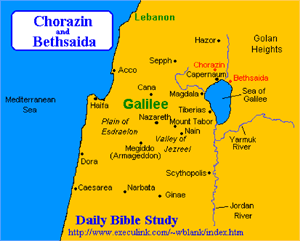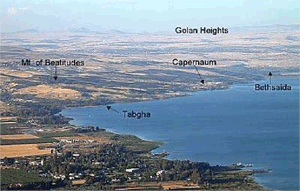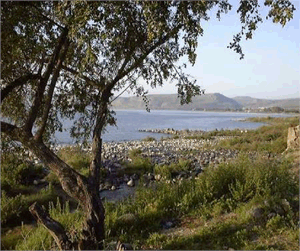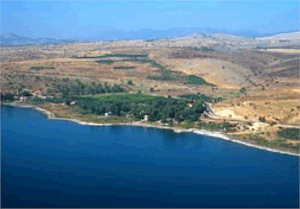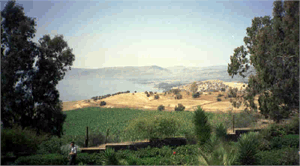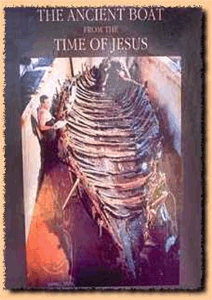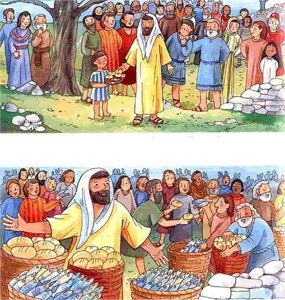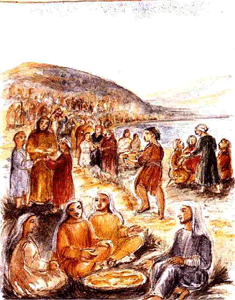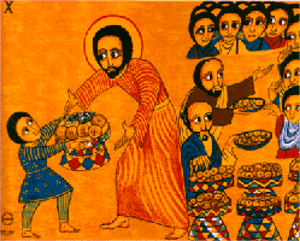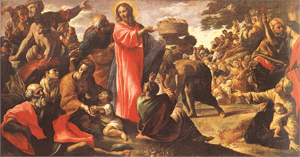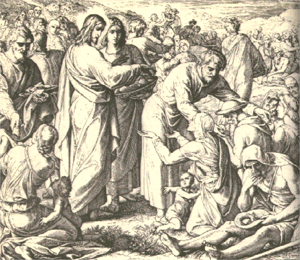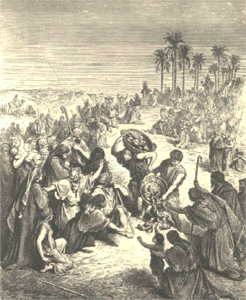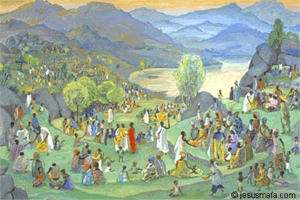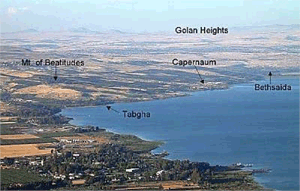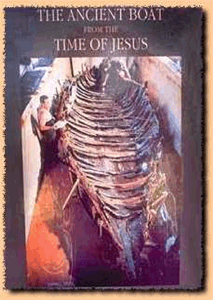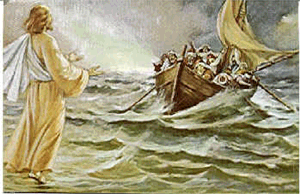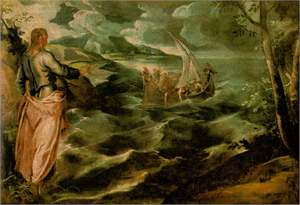
Christmas
Easter
Pentcoest
All Saints
Christ The King
Confirmation
Palm/Passion
Reformation
Stewardship
Books of the Bible
Lenten Series
Christmas Dramas
Videos
Series A - Matthew
Series B - Mark
Series C - Luke
Series D - Other
To contact
Edward F. Markquart
info@sfs.com
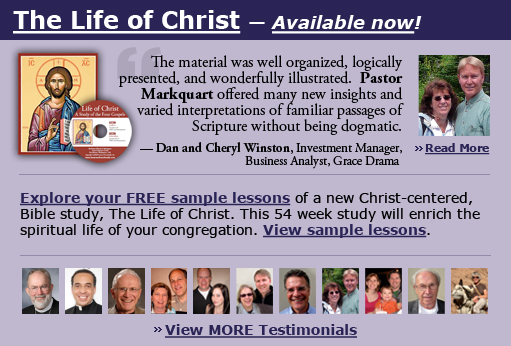
Series B PENTECOST 8B John 6:1-21 PENTECOST 11A Matthew 14:13-33 The following Bible study is from a larger course entitled, THE LIFE OF CHRIST: A Study in the Four Gospels. This 54 week course for the laity will be available for congregations in 2006. Basic text for the course: SYNOPSIS OF THE FOUR GOSPELS, Kurt Aland, English Edition, P. 135-138. ____________________________________________________________________ Introductory CommentsIn the lectionary for Series B, there are five consecutive gospel lessons from John 6. A pastor could preach five consecutive sermons based on John 6. All of these Sundays share a similar theme about Jesus, the Bread of Life, today and forever. The sermon series from John 6 could be as follows: Pentecost 8 Jesus, A Sign: Feeding of the Five Thousand Pentecost 9 Jesus, Bread of Life Pentecost 10 Jesus, Eternal Life Pentecost 11 Jesus, Holy Communion/Eucharist Pentecost 12 Jesus, Hard Sayings/Teachings of Jesus Each of the above sermons has a distinct focus. A sermon needs a distinct focus, a central theme. Even sermons from the Gospel of John, which often has numerous ideas in one text, needs to reflect a primary idea, a main theme, or a central focus . Helmut Thielicke, the famous preacher for the World War II era, wrote about the “textual-thematic” sermon. A sermon needs to be rooted in the text, but yet a preacher tries to find a central theme that will carry the sermon and that people can carry the sermon home with them. Other scholars have said that a sermon needs to have “the restraint of a single idea,” “the central kernel that saves the preacher/listener from getting lost in its details,” and “a thrust that can be expressed in one clear sentence.” The problem with preaching on a text from the Gospel of John is often no one, clear, central idea in that text. There are so many different themes within these Johanine texts that a sermon can easily lose its primary focus. Both the preacher and listener can get lost in the details. Also, we recall that both the gospels of Mark and John were written by eyewitnesses and both have a ring of historical authenticity to them. In Series B, the Pentecost season, twenty gospel lessons are from the Gospel of Mark; five are from the Gospel of John. Both are eyewitnesses. As lectionary preachers, we need to be aware that we may have addressed these two texts last year during Series A, Pentecost 11A (FEEDING OF THE FIVE THOUSAND) and 12A (MIRACLES AND WALKING ON WATER). It seems that both stories, THE FEEDING OF THE FIVE THOUSAND, and MIRACLES AND WALKING ON WATER, address needs and questions within the congregation. The story for today, about the five loaves and two fish, is not told merely once, not twice, not three times, but four times in its variations. It is the only gospel miracle which is told in its fullness in all four gospels. #146. Five Thousand Are Fed Matthew 14:13-21; Mark 6:32-34; Luke 9:10b-17; John 6:1-15 On the following map: Locate the Mediterranean Sea. Locate the Sea of Galilee. The Sea of Galilee is seven miles wide and thirteen miles long. The ancient historian, Josephus, who lived in 37-100 CE immediately after Jesus, first described the lake. Josephus estimated that the Lake of Gennesar was 40 statia wide and 140 stadia long. The lake is really 61 stadia wide (seven miles) and 109 stadia (thirteen miles) long. Locate the Jordan River. Locate the region or county of Galilee. Locate the village of Capernaum which was Jesus’ home in adulthood and the place of eight miracles. Locate the village of Bethsaida which was the city of Philip, Andrew and Peter. Bethsaida was two miles east of Capernaum and on the shores of the Sea of Galilee. Peter, Andrew, and Philip were from Bethsaida. John 1:43-45. "The next day Jesus decided to go to Galilee. And he found Philip and said to him, "Follow me." Now Philip was from Bethsaida, the city of Andrew and Peter.” Locate the triangle of three adjacent villages, Capernaum, Chorazin, and Bethsaida. Sometimes these villages are called “the evangelical triangle.” From the map study below, notice that these three villages are geographically close together. Locate the city of Tiberias, the city that the Roman emperor built in 18 CE and the Sea of Galilee which became known as the Sea of Tiberias. Locate the village of Magdala, the home village of Mary Magdalene or Mary from Madgala. http://www.execulink.com/~wblank/20020117.htm http://www.christiananswers.net/bibleplaces/home.html
The geography of Jesus: The picture below is a fantastic photograph and needs to be memorized in order to remember many of the most important geographic locations in Jesus’ life. This photograph will be repeated often in this course. Find and focus on the location of Tabgha, the traditional location of the feeding of the 5000.
Identify Capernaum. Christ did eight miracles at Capernaum: the dead daughter of Jairus raised; the evil spirit driven from a man in the synagogue; the paralyzed man let down through the roof and healed; the four disciples catch fish in a miraculous way, Jesus supplied tribute tax money via a fish; the centurion’s servant afflicted with palsy is healed; the son of a nobleman in the king’s court is healed; many others are healed. So the village of Capernaum was very important in Jesus’ healing and teaching ministry. Despite the unique number of miracles done at Capernaum, most of the residents of Capernaum remained unbelievers. It is amazing to us that the people of Capernaum witnessed more miracles and more teachings of Jesus than anyone in Galilee but their hearts were not touched by Jesus. They did not repent and become part of God’s kingdom. "For unto whomsoever much is given, of him shall be much required." (Luke 12:48). The people in Capernaum had been given much but they still did not believe. We, too, can see and experience wonderful miracles of God/Christ all around us, but we too can dismiss those miracles as insignificant and unimportant to us. There were two miracles of Christ that occurred at Bethsaida: Jesus healed a man born blind and he fed the five thousand with five loaves of bread and two fish. Tabgha is known as the traditional sight at which Jesus did the miracle of the feeding of the 5,000. The Biblical text is definite that the feeding of 5,000 was in a remote and lonely place, away from villages and away from places to obtain food. Therefore, it is assumed that Jesus was not in the village of Bethsaida but in the region of Bethsaida. http://www.rc.net/wcc/israel/lakegal4.jpg
http://www.ancientsandals.com/overviews/tabgha.htm Tabgha - location and profile
“Tabgha was a prosperous fishing village located on the northwestern shore of the Sea of Galilee. The name Tabgha is a corruption of the Greek word Heptapagon which means "seven springs." The water from individual springs there varies in temperature and salinity. (The most saline water from the springs is now being diverted in a channel around the lake.) The warm water from the springs attracted schools of fish, mostly musht, especially in the winter. Tabgha was a fishing suburb of Capernaum, the home and workplace of many who fished in the lake. The movement of the water from the springs at Tabgha was used to turn millstones to grind grain. Craftsmen at Capernaum fashioned these stones from the local basaltic rock, several of which remain near the synagogue there today. Many of the events in Jesus’ ministry, along the north shore of the Sea of Galilee, occurred in the area of Tabgha and Capernaum. Living within a half-hour’s walk of Tabgha, Jesus would have known it well.” (End of website quotation from the above website) The miracle of the feeding of the five thousand is the only miracle told in all four gospel accounts. There are different settings for the feeding of the 5000 in the first three gospels and feeding of the 5000 in the fourth gospel. In the first three gospels, having heard of the gruesome death and beheading of John the Baptist, Jesus withdrew to a lonely place in order to grieve the loss of the Baptist. In the Gospel of John, “after this” is a reference to the previous healing of the handicapped man of thirty-eight years. This event occurred in Jerusalem which was located some eighty miles south of the Sea of Galilee. There is no description in the Gospel of John about Jesus traveling eighty miles from Jerusalem north to the Sea of Galilee in order to feed the 5000. There are many parallels of sequence in all four gospels. Highlight or circle that progression of words/ideas in the gospels e.g.
From the similarity of numerous details and the similarity of the progression of the story, we know that we are reading the same story in all four accounts in our four gospels. The Gospel of John has several unique and distinctive emphases:
The following is a view of Lake Galilee from “The Mountain” where Jesus taught his disciples during the Sermon on the Mount, where Jesus went to pray during the miracle of the feeding of the 5000 (John), and where Jesus went alone to pray before the miracle of the walking on water (Matthew and Mark.) http://www.biblicalisraeltours.com/photos99/1.3.JPG
#146. Five Thousand Are Fed (The following is a combination of the event from the Gospel of Mark and the Gospel of John.) Mark 6, John 6 We recall that both the Gospels of Mark and John were written by reliable witnesses. The stories in Gospel of Mark are the reminiscences of Simon Peter and the stories in the Gospel of John are the reminiscences of John. In the following event, we are conflating two reliable eyewitness accounts. From the Gospel of Mark -He said to them (his disciples,) "Come away to a deserted place all by yourselves and rest a while." For many were coming and going, and they had no leisure even to eat. And they went away in the boat to a deserted place by themselves. Jesus wanted to have his disciples go to a deserted place and rest a while. Like us on many occasions, we are so busy that we don’t time to eat. Highlight/underline the phrase “no leisure to eat.” That happens to us many times in our lives and Jesus then wants to take us to a quiet place where we can find some rest, time and sanity. Circle the word, “boat.” The disciples and Jesus left the fishing village and were going to travel by boat to a deserted place. We recall from earlier lessons the archeological find of a boat from the time of Jesus. The boat was 26 feet long and had room for 15 passengers.
Note that Matthew tells us that the disciples and Jesus were grieving the death/beheading of John the Baptist. John the Baptist was a first cousin of Jesus and several of Jesus’ disciples were originally disciples of John the Baptist. John the Baptist had baptized Jesus. So all the disciples and Jesus had significant connections to this man who had been viciously beheaded by Herod the Tetrarch. -Now many saw them going and recognized them, and they hurried there on foot from all the towns and arrived ahead of them. The crowd was large and numbered 5000 men, not including women and children. There must have been a dust storm on the shores of Lake Galilee as this massive crowd was following Jesus into a deserted region away from the villages. -As he went ashore, he saw a great crowd; and he had compassion for them, because they were like sheep without a shepherd; and he began to teach them many things. Circle the word, “great,” and write in the words, “5000 plus women and children.” Circle the word, “compassion,” and remember that Jesus had the compassionate mind and heart of God within him. That is the way that God feels towards you and me: compassionate. Underline, “sheep without a shepherd.” This also becomes a primary metaphor of Jesus. Jesus is the Good Shepherd and we are the sheep whom Jesus cares for, feeds, waters, protects, and leads on the wise paths of life. Underline, “he began to each them many things.” We have been studying the parables and miracles of Jesus who continues to teach us today many things. -When it grew late, his disciples came to him and said, "This is a deserted place, and the hour is now very late;send them away so that they may go into the surrounding country and villages and buy something for themselves to eat." The disciples looked at the size of the crowd and told Jesus to send them to villages and the countryside where they could buy something to eat. Like most of us in life, they were not expecting that a miracle would unfold right before their eyes in the coming events. (The following sequence is from the Gospel of John) -After this Jesus went to the other side of the Sea of Galilee, also called the Sea of Tiberias. We recall that the Sea of Tiberias was named after the Roman Emperor Tiberias when he built the city of Tiberias in 18 CE. -A large crowd kept following him, because they saw the signs that he was doing for the sick. According to the gospels parallels of Mark and Matthew, we know the crowd was large and numbered five thousand men, besides women and children. -Jesus went up the mountain and sat down there with his disciples. -Now the Passover, the festival of the Jews, was near. -When he looked up and saw a large crowd coming toward him, Jesus said to Philip, -"Where are we to buy bread for these people to eat?" -He said this to test him, for he himself knew what he was going to do. Jesus tests our hearts to see what is in them. Throughout the whole Gospel of John, Jesus repeatedly knew what he was going to do. Throughout the whole Gospel of John, we will encounter the “omniscience” (all knowingness) of Jesus. -Philip answered him, “Six months’ wages would not buy enough bread for each of them to get a little.” The other gospels tell us two hundred denarii or two hundred days wages would not be enough to buy food for all these people. -One of his disciples, Andrew, Simon Peter's brother, said to him, "There is a boy here who has five barley loaves and two fish. But what are they among so many people?" The first three gospels do not tell us the story of the lad with the five loaves and two fish. Centuries later, readers of the gospels prefer the story with the five loaves and two fish. The boy humanizes the story, and we like this shape of the story better. -Jesus said, "Make the people sit down." John gives us a juicy piece of information. That is, Jesus made the people sit down. -Now there was a great deal of grass in the place; so they sat down, about five thousand in all. Circle the words, “a great deal of grass in this place.” Again, it is a nice, historical, juicy detail. -Then Jesus took the loaves, and when he had given thanks, he distributed them to those who were seated; so also the fish, as much as they wanted. Since the next story in the Gospel of John is the story of Jesus giving the Bread and Wine in the Eucharist (Holy Communion), many scholars conclude that the references to “taking the loaf, giving thanks, distributing it” are parallel actions found in Holy Communion. The crowd was given as much bread and fish as they wanted. There was a superabundance of resources that Jesus had created or found. They were satisfied with the meal that had been given to them. -When they were satisfied, he told his disciples, "Gather up the fragments left over, so that nothing may be lost." So they gathered them up, and from the fragments of the five barley loaves, left by those who had eaten, they filled twelve baskets. Twelve is a symbolic number standing for the twelve tribes of the Old Testament or the twelve disciples/apostles of the New Testament. -When the people saw the sign that he had done, they began to say, "This is indeed the prophet who is to come into the world." This miracle was a sign from Jesus that he was the Son of God who satisfies the hearts of all people. The crowds think that he is THE prophet having returned earth, that Jesus was perhaps Moses or Elijah or some other prophet from the Old Testament. Some thoughts about the message and meaning of this story for our lives
I like what one commentator suggested: Some people want Jesus to change the loaves of the loaves of bread themselves, so that the loaves continually multiply endlessly, so that the loaves themselves experience transformation and become an endless supply of bread. But others suggest that what was really transformed were the selfish hearts of five thousand men; that when these five thousand men saw the example of the boy giving Jesus his five loaves of bread and two fish, these men were inspired to look inside their coats and share the food they had brought with them, hidden inside their clothing. The real transformation then, was not of the loaves, but of five thousand selfish hearts. The Bible says: “A little child shall lead them.” I ask you: Which would be the greater miracle? The transformation of the loaves or the transformation of selfish hearts? I would like to suggest to you that some would prefer to focus on the transformation of the loaves in order to avoid focusing on their own selfish hearts that need to be transformed. Some people focus on the magic of the story in order to avoid the transforming miracle needed in every human heart. 3) There are clear references to Holy Communion in this text. The liturgical references seem clear. “Jesus took the bread...looked up to heaven...gave thanks (gave Eucharist)...broke the bread...gave it to his disciples...who gave it to everyone...and they all ate and were satisfied.” These actions are parallel to Holy Communion. We then read the Gospel of John’s version of this story, and we discover that the feeding of the five thousand is a prelude to Jesus’ teaching that “I am the Bread of life” and Holy Communion. In John, chapter six, we also find the most complete description of Holy Communion in the whole Bible. In John, chapter six, Christ says: “I am the Bread of life. Whoever eats my flesh and drinks my blood, I live in that person and that person lives in me.” “Whoever eats my flesh and drinks my blood will never die but live forever.” Incredible words. Incredible promises. And so in the Gospel of John, chapter six, the feeding of the 5000 is a prelude to Jesus’ teachings about Holy Communion. The two events are directly connected.
MIRACLE OF BREADS JN 6 // COLETTE ISABELLA,20,FRA, http://membres.lycos.fr/apax2/images/jn06a/index.htm
Notice that this picture envisions a magical transformation of the fish, so that we see bushels of fish and bushels of bread. We don’t see a miraculous transformation of human hearts in which peoples’ selfishness hearts were transformed and then the people brought the loaves of bread and fish out from underneath their garments where they had been hiding loaves of bread and dried fish. In this course, it is interpreted that “the miracle” was Jesus’ transformation of selfish human hearts into generous human hearts. MIRACLE OF BREADS JN 6 / AURORE,20,FRA, http://membres.lycos.fr/apax2/images/jn06a/index.htm
http://www.stanthonyshrine.org/art_exhibits/Hospitality_art.html
http://www.wga.hu/frames-e.html?/html/l/lanfranc/miracle.html
http://kcm.co.kr/bible01/lr/r-154.html
http://kcm.co.kr/bible01/gd/gd163.html
http://www.jesusmafa.com/anglais/imag24.htm
Jesus’ feeding of the 5000 and walking on water are two important miracles that are often highlighted in conversations when Christians talk about the miracles of Jesus. In this course, let us pause for a moment between these two miracles and talk about miracles in the Bible and miracles in our own lives. COMMENTS ABOUT MIRACLES (SIGNS) From the course, A SLOW WALK THROUGH THE OLD TESTAMENT, Lesson 23, The Plagues and Miracles
147. The Walking on the Water Matthew 14:22-33, Mark 6:45-52, John 6:16-21 This is another gospel text that needs to be carefully studied. Most of us know that the gospel stories teach that Jesus walked on water. For us in the twentieth century world, there are certain miracles of Jesus that grab our attention more than others because there are no apparent psychological explanations for the occurrence of those miracles. That is, we modern people may rationalize about healings (Jesus healed people with severe mental problems) and feeding five thousand (Jesus transformed selfish hearts), but it is more difficult to rationalize other miracles of Jesus such as the turning of water into wine and walking on the water. This miracle of walking on water grabs our attention and we need to examine it carefully. In the Gospel of John, the reader would have expected to go directly from the feeding of the 5000 to the teaching about Jesus, the Bread of life. But in between the feeding of the 5000 and the teaching about the Bread of life, we hear the story of walking on water. Raymond Brown, in his famous commentary on John, comments: “Since it would have been simpler for the fourth evangelist, if he were simply a creative artist, to have placed the discourse on bread immediately after the multiplication, his inclusion of the walking on the sea indicates that he was controlled by an earlier tradition in which the multiplication and walking on the sea were already joined.” (V. I, p. 252). Let us carefully examine the texts. We especially like the historicity of the gospel accounts of both Peter (Mark) and John. We notice the parallels that are woven into the story in the three gospels:
-Immediately he made his disciples get into the boat and go on ahead to the other side, to Bethsaida, while he dismissed the crowd. Jesus has just finished feeding the 5000. Mark tells us that the destination was the village of Bethsaida; John tells us that the destination was Capernaum which was another two miles further than Capernaum. Imagine a boat rowing/sailing from Tabgha to Capernaum or Bethsaida. Examine the following photograph so you can imagine the route.
-After saying farewell to them, he went up on the mountain to pray. We look at the above photograph and see the Mount of Beatitudes where Jesus gave his teachings for the Sermon on the Mount. -When evening came, the boat was out on the sea, and he was alone on the land. The disciples were in the boat rowing to their destination; Jesus was alone of the seashore. Although Mark does not say it, Jesus had returned from the Mount of Beatitudes where he had been praying and was now alone on the seashore. That is, Jesus could actually see the disciples from his vantage point on the shore. We remember from Lesson 6 that the remnants of a 2,000 year old fishing boat from the northwest shores of the Sea of Galilee was 26 feet long and 7 feet wide and could carry 15 people.
-When he saw that they were straining at the oars against an adverse wind, Jesus could see the disciples as they were rowing against a nasty wind that was kicking up a storm. -When they had rowed about three or four miles (only John).John tells us the disciples had rowed about three to four miles (Footnote M at the bottom of the page, “in Greek, twenty-five or thirty stadia.”) Matthew tells us they had rowed many furlongs distance. In other words, the disciples had rowed three to four miles from their original point of embarkation, Tabhga, and after three or four miles of rowing, they would have been close to Capernaum. -He came towards them early in the morning, walking on the sea. See the comments by Barclay in the next section. Circle the word, “on.” This is a key translation of the Greek word. We are going to discover that elsewhere in the Gospel of John, that same word is translated, “by.” That is, “Jesus came toward them early in the morning, walking BY the sea.” For the moment, simply focus on the preposition, “on.” Jesus was walking ON the sea. http://www.biblia.com/jesusm/water.htm
http://www.wga.hu/art/t/tintoret/2religio/galilee.jpg
-He intended to pass them by. -But when they saw him walking on the sea, they thought it was a ghost and cried out; for they all saw him and were terrified. The disciples thought that they were seeing a ghost and were terrified by what they saw. Circle the preposition, “on.” Jesus was walking ON the sea. -But immediately he spoke to them and said, "Take heart, it is I; do not be afraid." Underline. Highlight. Focus on. Christ/God are constantly inviting us to take heart and not be afraid of what we are facing in life. -Then he got into the boat with them and the wind ceased. And they were utterly astounded, for they did not understand about the loaves, but their hearts were hardened. When Jesus got into the boat, the winds ceased and they were astounded and amazed. The miracle is that Jesus controlled the wind and the waves, as he did earlier when he calmed the storm. The miracle of this particular story is that Jesus stilled the storm. In John’s gospel, the “walking on water” is not called a sign. So far in John’s gospel, there have been four signs/miracles which were followed by four discourses: water into wine, the healing of the centurion’s son, the healing of the 38 year old paralytic near the poolside, and the feeding of the 5,000. In John’s gospel, “walking on water” is not a referred to as a sign or miracle. -Peter answered him, "Lord, if it is you, command me to come to you on the water." Matthew’s edited this story and this incident is only found in Matthew’s gospel. Peter, the lead disciple, is going to come out onto the water. As in all the Peter stories, Peter is pro-active and the first to speak or take action. We remember other stories about Peter and his being pro-active: the call of the first disciples, the Mount of Transfiguration, the Garden of Gethsemane, in the court yard of the high priest (cock crowing), his professing faith that we disciples will never deny you, his cutting off of the ear of the high priest’s servant, his telling Jesus at the last resurrection appearance that he will be the loyal shepherd. Peter always seems to be in the middle of the action. We remember that this story of Peter walking on water and starting to sink is from the the Gospel of Matthew. - He said, "Come." So Peter got out of the boat, started walking on the water, and came toward Jesus. We find Peter starting to walk on water and experiencing a miracle. But when he noticed the strong wind, he became frightened, and beginning to sink, he cried out, "Lord, save me!" Here is the problem. Peter took his eyes and his faith off of Jesus Christ and began to focus on the storm raging about him. He became afraid and began to sink. He cried out, “Lord, save me.” That is our situation all the time. We take our eyes off of Christ and focus on the storm and begin to sink and drown. -Jesus immediately reached out his hand and caught him, saying to him, "You of little faith, why did you doubt?" Jesus did not let Peter sink and drown. Jesus caught Peter when he was drowning and will catch us as well. Jesus will also ask a basic and simple question of us: “Why were you doubting me in the middle of your storm?” -When they got into the boat, the wind ceased. And those in the boat worshiped him, saying, "Truly you are the Son of God." This is the miracle: that the wind ceased when the two of them got into the boat. Underline the words, “the wind ceased.” These are precisely the words from the miracle in Mark 4:39 (p. 78). The miracle is that Jesus calmed the storm on the lake with his word of command. Not that Peter walked on water for a few steps. Realizing that Jesus calmed the storm, the disciples in the boat worshipped him and confessed that he was/is the Son of God. That is what Jesus wants from you and me: to realize that Jesus is more powerful than nature, to realize that Jesus is none other than the Son of God, the mind and heart of God in the flesh of a human being. Jesus wants us to worship him as much as we worship God the Father, God the Creator. Some people title this story as “Jesus walking on water” and the miraculous essence of this story is that Jesus walked on the water. The way that a person titles the event shapes the way we see the event. Other people title this story as “Jesus calming the storms” and the miracle is when Jesus calms the storms in nature and the storms in our lives.
A footnote. The following comments are a perspective about walking “on” water by a believing rationalist, William Barclay, in his commentary, THE GOSPEL OF JOHN, V. 2, p. 208. Barclay’s thoughts offer us a different perspective to this story that most of us have not previously thought about. For a moment, let us try to get into the thought pattern of the modern rationalist, Barclay. A critical phrase in this story is “walking on the sea.” The key issue is the translation: “on the sea” or “by the sea.” Let those two prepositions sink into your mind: “on the sea” verses “by the sea.” Barclay writes in his commentary, “The Greek is ‘epi tes thalasses’ which is precisely the phrase used in John 21:1, where it means—it has never been questioned—that Jesus was walking on the seashore. That is what the phrase means in our passage too.” (Briefly turn to p. 336 in your text, THE SYNOPSIS OF THE FOUR GOSPELS and underline John 20:1, “by the sea.” The same Greek words in John 6:19 are translated, “on the sea.”) Barclay continues, “Jesus was walking bythe seashore. The toiling disciples looked up and suddenly saw him. It was all so unexpected. They had been bent so long over their oars that they were alarmed because they thought it was a spirit they were seeing. … Remember that the breadth of the lake was four miles at this end of the lake and that they had already rowed that distance. The simple reason is that before they could take Jesus on board, the boat grounded on the shingle (land) and they were there.” If Barclay’s analysis of this story is true, the miracle or sign would not be the walking on the water so much as it is the calming of the wind. The title of this event would not be “Jesus walking on the water” but “Jesus calming the storm.” This miracle would be then similar to Jesus’ stilling of the storm that we read about on p. 77 (Jesus stilling the storm) and in which Jesus demonstrated his power over nature. The preaching theme of the story becomes Jesus’ words, “Take heart; do not be afraid. It is I.” Jesus’ comforting and strengthening words occurred in the middle of a storm, as they do in the middle of the storms of our lives. A question is: Why were the disciples utterly astounded? Because of Jesus walking on water and/or because the wind ceased? In either interpretation, the story tells that Jesus had power over nature and the story becomes another significant miracle that confirms that Jesus was/is the Son of God, the Mind and Heart of God in human flesh. At the conclusion of the story, both Matthew and Mark say that the wind ceased and the disciples worshipped him or were utterly astounded by what happened. Unconsciously, we title this miracle, “Walking on Water,” and not “Calming the Storm.” The title that we give to this miracle affects the way we think about it. In Barclay’s thought pattern, Matthew has an additional story about Peter walking on water and then sinking. For Barclay, this would be a later addition to the more original story by Mark and John. In Matthew’s story about Peter, Peter sinks into the water, presupposing a greater depth of water. It is only the Gospel of Matthew that has the story about Peter sinking in the surf. The Gospels of Mark and John do not. Scholars like Barclay would suggest that this section of the Matthew story is a later addition to the earlier accounts by John Mark (via Peter) and John. Both Peter and John are to be considered eyewitnesses. Matthew is not. For scholars like Barclay, the walking on the water story still communicates its essential message without the additional story about Peter. What is the essential message of this story? Jesus is the Son of God who calmed the storming wind, whereby the disciples were astonished and worshipped him. The Peter story also fits with the teaching of Jesus, “Take heart. Do not be afraid. It is I.” From another commentary, Bible Gateway. http://www.biblegateway.com/cgi-bin/webcommentary?language=english&version=niv&book=john&chapter=6 “In these six verses two miracles are recorded that each reveal Jesus as the master over the natural realm. The first is his walking on the water to reach the disciples. Many have suggested that John does not intend for us to believe Jesus walked upon water but that John is saying Jesus was walking along the shore next to the sea. The Greek language allows such an interpretation (epi tes thalasses has this meaning in 21:1.” Excerpts from a sermon about Jesus walking on the water: “We need to be reminded that the concept of miracles is part of our everyday modern life and experience. The word, “miracle,” and the experience of the miraculous, is in no way confined to Biblical times or the first century. The word, “miracle,” and the experience of the miraculous, is very much part of our modern world and our everyday lives. In spite of all the technological advances and scientific sophistication, the word, “miracle,” is still very much part of our contemporary vocabulary and the experience of the miraculous is very much part of our everyday lives. Let me illustrate. You open the refrigerator door and you pull out a jar of Miracle Whip, a mayonnaise that spreads so nicely across your bread. Or you pull out a small, flat bag and put it into the microwave, and “wallah!,” it puffs up and you have instant popcorn, and you say, “What a miracle!” ... You go out to the garden and you pour Miracle Grow onto your plants and they flourish so splendidly, thanks to Miracle Grow. ... A rocket is shot up into the air and a man for the first time plants his first footprint on the moon, and everybody called it a miracle ... It wasn’t that many years ago that penicillin was discovered and everyone called it a miracle drug. Soon after that, in the early 1950s, Dr. Salk discovered the Salk vaccine to vaccinated against polio and all of our parents said it was a miracle. And recently, the smallpox vaccination was given to children throughout the whole earth and there is not one case of smallpox anywhere on the globe and everybody would agree that is a miracle. And when a vaccination or the equivalent is discovered for cancer or cancers, the headlines will shout for joy: “Miracle drug found for cancer!” ... There was a car accident the other day and the body of the car was totally smashed, and those who saw the car exclaimed: “It is a miracle that anyone came out of that smashed car alive.” ... Births and adoptions often evoke the word, miracle. A baby is born, and the parents almost automatically say, “This is a miracle,” and the parents who have been struggling with infertility for five, ten, or fifteen years, when their child is born, truly believe that their child is a miraculous gift from God. What I am suggesting to you is that the word, “miracle,” and the experience of the miraculous is not confined to Biblical times and the first century. The word, “miracle,” and the experience of the miraculous is interwoven throughout our modern lives. We use the word, “miracle,” all the time. Miracles aren’t necessarily Biblical magic which confounds the mind such as the body levitating or floating in air; or the magic of a shorter leg miraculously stretching out three to four inches. The focus of miracles isn’t on some magical voodoo or natural laws that have been violated. Rather, a God given miracle is a series of events and the timing of events in such a way that convince us that God has intervened in our lives. The result of such miraculous intervention is the experience of awe and adoration. That is, we go “wow!” and then we worship God in thanksgiving for the miracle. It is with this understanding that we approach the miracle story for today, Jesus walking on the water. We need to create the setting. In Matthew’s Gospel, we have seen Jesus do several miracles in a row. Jesus stilled the storm on Lake Galilee and this demonstrated his power over nature. Jesus then raised Jairus’ daughter from the dead which demonstrated his power over death. Jesus then cured the sick which demonstrated his power over disease. Jesus then caste out demons, which showed his power over the demonic. In the previous story, Jesus has just fed five thousand men plus women and children with five loaves of bread and two fish, and this demonstrated his power over selfishness. In other words, the miracle of the walking on the water occurs immediately after several other miracle stories in the Gospel of Matthew. Walking on the water demonstrates his power over nature. In a similar way, Jesus stilling the storm on Lake Galilee also demonstrates his power over nature. And Jesus, after feeding the five thousand, Jesus sent the crowds home and sent his disciples out in a boat in Lake Galilee. Lake Galilee is a large lake, seven miles wide by thirteen miles long. Jesus himself went up into the hills to pray. Meanwhile, a vicious storm came up on the lake. The waves were enormous as the disciples were rowing in the middle of the storm in the middle of the night. It was about three o’clock in the middle of the night, and the disciples were frightened, terrified, by the storm. And suddenly, Jesus appeared to the disciples, walking on the water. The Bible says that the disciples were frightened, terrified, crying out, utterly astounded by what they saw, as if they were seeing a ghost. Their reaction wasn’t, “There is Jesus, just like we expected, walking on the water. He must be God.” No, the disciples were frightened, shocked, and stunned by what they experienced. Jesus, seeing their fears, said to them, “Do not be afraid; it is I.” And so also, the Lord Jesus, seeing our fears and insecurities, says to us: “Don’t be afraid of me. Do not be afraid.” Then Peter, in Matthew’s gospel, being brave of heart or a bit foolish, asked, “Jesus, can I come onto the water?” Jesus said, “Come,” And Peter came. He kept his eyes focused on Jesus, on the face of Jesus, on the eyes of Jesus, on the presence of Jesus. But then suddenly Peter’s eyes were diverted away from Jesus and he focused on the wind, on the water raging about him, on the storm. Doubts overwhelmed him and he started to sink, crying out, “save me.” And Jesus, immediately, not waiting for five seconds or five minutes to teach Peter a lesson, “immediately,” the Bible says, Jesus reached out to Peter and saved him. And when they got into the boat, the storm calmed and the disciples were in awe, in fearful reverence of Jesus, and they worshipped him as the Son of God. They praised him in thanksgiving for saving them. Not being able to explain what happened or how it happened, those disciples believed that they had experienced a miracle; that the sequence of events and timing of events convinced them that God, that Christ, had intervened and saved their lives. And what was their reaction? They experienced awe and holiness. They worshipped him in thanksgiving. They concluded: “Truly, Jesus is the Son of God. A few comments. When we experience a miracle in the Bible or in real life, we often want to explain what is unexplainable. And so we rationalize and intellectualize, trying to figure out what happened. We think like Greeks. For example, we try to explain the walking on the water. You perhaps have heard this joke. I have it what seems a thousand times. A rabbi, a priest and a Lutheran pastor were fishing in a boat together, not far from land. The rabbi used up all his bait, noticed a bait shop a short ways away, got out of the boat, walked on water to the bait shop, returned the boat, walked back on water and started fishing again. A short time later, the priest ran out of bait, walked on water over to the bait shop and back again and started fishing. Then, the Lutheran pastor ran out of bait, had a look of doubt on his face, stepped out of the boat and sank. The rabbi and priest said: “Hey, dummy, don’t you know where the reef is?” ..... What a sick joke. It’s a groaner. If I have heard it once, I have heard it a thousand times. It is the kind of joke that church members love to tell their pastor. Behind that joke, there is the rationalization, the attempt to explain how Jesus walked on water. He walked on a reef. Jesus knew where the reef was but Peter didn’t and sank. Or some commentators will legitimately suggest that the Greek language implied that Jesus walked “beside the water,” and the disciples thought he was walking on water. The disciples couldn’t clearly see in the storm that Jesus was walking beside the water, not on the water. These are attempts to rationalize, to explain, to think like a Greek, and ask “how did this happen.” But what I am suggesting is that something happened that night that we and they don’t quite understand, but in the sequence of events and in the timing of those events, they experienced the miraculous saving power of God in their lives. That’s the miracle, theexperience of God’s intervening and saving Presence in their lives. It’s not magic. It’s not proving how it happened. That’s the wrong focus. What I am suggesting to you is that the disciples were in a boat in the middle of a ferocious storm and were scared spitless, thinking that they were going to die. Jesus came to them, walking on the water and saved them. They were awestruck by what they experienced, encountering the holiness of God, and then they worshipped Christ as the Son of God in appreciation for what he had done for them. They couldn’t explain it; anymore than we can explain miracles that happen to us. I am always amazed at the large number of people who tell me that they are a “walking miracle;” that God has intervened and saved them, rescued them, healed them, strengthened them; that they could not have made it without God. I hear such comments often, and the focus is never on the how the miracle happened or rational explanations for the miracle or the magic of it. The focus is always on God’s intervention in their lives and their deepest appreciation for God’s deliverance. The focus is not on thehow but on God’s miraculous deliverance. The focus is not on explanations but on deliverance. And such people worship God, praise God, thank God for all God’s goodness. A second comment about this miracle: Peter sinking in the waves of the storm. As a little boy, going to worship every Sunday morning of my life, that picture of Peter sinking in the waves of the storm was the center of our church’s altarpiece. It was a picture of Peter, outside the boat, sinking in the turbulent waves, Jesus holding onto his arm, rescuing him. Every Sunday morning, we sang the hymn “Holy, Holy, Holy” and looked at that picture of Simon Peter as he was doubting Jesus and sinking into the water. The picture is vividly engraved into the souls of many of us whose altars were similarly decorated. A person cannot help but concentrate on Simon Peter; how he got out onto the water with his eyes focused on the eyes of Jesus, on the face of Jesus, on the Presence of Jesus; and there for a moment of doubt, his eyes were diverted to the wind, to the storm, to the size of the waves; and he sank. And so it is with us so often in our lives. Rather than focusing on the eyes of Jesus, the face of Jesus, the Presence of Jesus, we focus on the storm which is raging in our lives and we start to sink...because we are focusing on the storm rather than on the saving Presence of God in our lives. The story is told by “old salt” sailors of how to climb the mainsail to the crow’s nest, high above the wooden sailing vessel. On an old sailing ship, there is a tall mainsail and the crow’s nest is perched there, at the very top of the highest mainsail. In your imagination, can you see the crow’s nest up there at the top of the mast? It is scary enough to climb to the crow’s nest when the sea is smooth and calm; but it is very frightening to climb to top of the mainsail and into the crow’s nest in the middle of a raging storm. The sea vessel is swaying this direction and that, and the movement at the top of the mainsail sways even more, as the boat rocks back and forth. The old sailors tell you, when climbing to the crow’s nest in the middle of a raging storm, never ever look down....or you will fall. Never look down into the storm or you won’t make it. Remain keenly aware of the storm all around you, but don’t look down into the storm or you will get sick and fall. Keep your eye on the crow’s nest. And so it is with us: in the middle of the nastiest storms of life, and the storms of life can be so nasty, it is wise, so very wise, to keep our focus up on God, up on the face of Christ, up on the strength and power of God, rather than on the storm. I have heard it so often: “I would not have made it through that storm if I hadn’t focused on Christ, on the cross, on God. I had to keep looking up to God to survive.” Keep your eyes on the crow’s nest in the storm! Keep your eyes up on the face of Christ! At the core of the story is Jesus’ statement: “Take heart. Do not be afraid. It is I.” We are perpetually afraid of the next chapter in our lives. We are afraid of the storms of life: the report of the doctor that our loved one has a terminal disease, the advice that we need to move out away from what has been our home for fifty years, the evaluation that we no longer have our job. Into the storms of our lives, Jesus says, “Take heart. Do not be afraid. It is I. I am with you.” And, when it was all said and done, these series of miracles convinced the disciples and the early church that Jesus was the Son of God. These people of the Bible experienced several miracles in a row: the stilling of the storm, the raising of Jairus’ daughter, the healing of the lepers, the casting out of demons, the feeding of the five thousand, then the walking on water and deliverance from the storm. And finally, the disciples slowly came to the conclusion and realization, “Truly, this is the Son of God.” And they worshipped Christ as Lord. And through a series of events in our lives, incomprehensible to us, God works on us and in us in such a way that we, too, are stopped in our tracks and slowly we come to the realization: “Jesus, you are the Son of God. We worship you.” Miracles. The experience of the miraculous. I have found that the word, “miracle,” and the experience of the miraculous is not confined to the Bible and the first century. I have found that the word, “miracle,” and the experience of the miraculous, is very much a part of the modern world, very much a part of your life and mine. Amen.” (End of sermon) This is a link to an article that theorizes that Jesus walked on a sheet of ice. |
